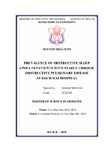
Please use this identifier to cite or link to this item:
http://dulieuso.hmu.edu.vn/handle/hmu/1073| Title: | PREVALENCE OF OBSTRUCTIVE SLEEP APNEA IN PATIENTS WITH STABLE CHRONIC OBSTRUCTIVE PULMONARY DISEASE AT BACH MAI HOSPITAL |
| Authors: | NGUYEN HOAI, NAM |
| Advisor: | Le Khac, Bao M.D., Ph.D Associate Professor Vu Van , Giap MD., Ph.D |
| Keywords: | Internal Medicine;8720107 |
| Issue Date: | 2020 |
| Publisher: | ĐHY |
| Abstract: | Chronic obstructive pulmonary disease (COPD), characterized by irreversible airflow obstruction, is a huge burden in public health worldwide including Vietnam. In 2010, the prevalence of COPD among adults (23-72) in northern Vietnam was 7.1%, accounting for 10.9% male and 3.9% female population 1. In 2017, the European COPD prevalence was estimated at 10.8 – 14.2% depending on geographical regions 2. In 2014, COPD prevalence among the US adults aged 40 to 70 was 4.2% 3. Despite big progress in treatment, COPD has still been one of the most common causes of death in Vietnam: the 4th among the 10 top death causes in 2017, after stroke, ischemic heart disease and lung cancer 4. COPD comorbidities such as obtructive sleep apnea (OSA) contribute greatly to this high COPD mortality. OSA is characterized by periodic apneas and hypopneas during sleep, which causes daytime sleepiness, reduces quality of life, and damages cardiopulmonary system 5. A study in America in 2017 showed a prevalence of OSA about 9% - 38% of the general population 6. A study in Vietnam in 2018 found an OSA prevalence of 8.5% 7. Patients with OSA have impaired cognition, decreased concentration and memory, fatigue, psychological stress, decreased sexual activity, and reduced quality of life 8, 9. OSA, if left undiagnosed and untreated, leads to many serious medical, economic and social consequences. Unfortunately, according to Vishesh Kapur, in American communities in 2002, up to 80 – 90% of patients with this syndrome were not diagnosed and treated 10. Coexistence of COPD and Sleep-disordered breathing (mainly obstructive sleep apnea [OSA]) causes more severe nocturnal hypoxemia than either disease alone 11. Compared with patients who have either OSA or COPD alone, patients with the Overlap syndrome have poorer quality of life, increased morbidity and mortality 12. A recent retrospective study reported a higher prevalence of hypertension, diabetes and the metabolic syndrome in patients with the overlap syndrome compared to OSA alone 13. Studies now show that for patients with OSA, a reduced FEV1 or a history of smoking may lead to increased mortality 14. In one study, there was a seven-fold increase in the risk of death in patients with COPD and OSA compared to patients with OSA alone 15. In patients with overlap sydrome (OS), oxygen desaturation, hypercapnia, pulmonary hypertension can occur at mild or moderate airflow obstruction. Therefore, the diagnosis and treatment OSAS in patients with stable COPD is essential to decrease mortality, and improve quality of life. As far as we know, there are only a few studies on characterisstics and outcomes of patients with OSA-COPD overlap sydrome in Vietnam. In Bach Mai hospital, in 2015, Phan Thanh Thuy conducted a study on 60 hospitalized patients due to COPD exacerbations and found a prevalence of OSA among COPD patients of 66.7% 16. Hospitalized patients with COPD exacerbations might have difficulty falling asleep 17, making the OSA diagnosis unreliable. Therefore, we decide to conduct this study for answer the question: “What is prevalence of OSA in patients with stable chronic obstructive pulmonary disease at Bach Mai hospital?” with 2 specific objectives: 1. To investigate prevalence and charateristics of obstructive sleep apnea among stable chronic obstructive pulmonary disease patients. 2. To describle some risk factors of obstructive sleep apnea among stable chronic obstructive pulmonary disease patients. |
| URI: | http://dulieuso.hmu.edu.vn//handle/hmu/1073 |
| Appears in Collections: | Luận văn thạc sĩ |
Files in This Item:
| File | Description | Size | Format | |
|---|---|---|---|---|
| 2020THS0107.pdf Restricted Access | 2.55 MB | Adobe PDF |  Sign in to read |
Items in DSpace are protected by copyright, with all rights reserved, unless otherwise indicated.